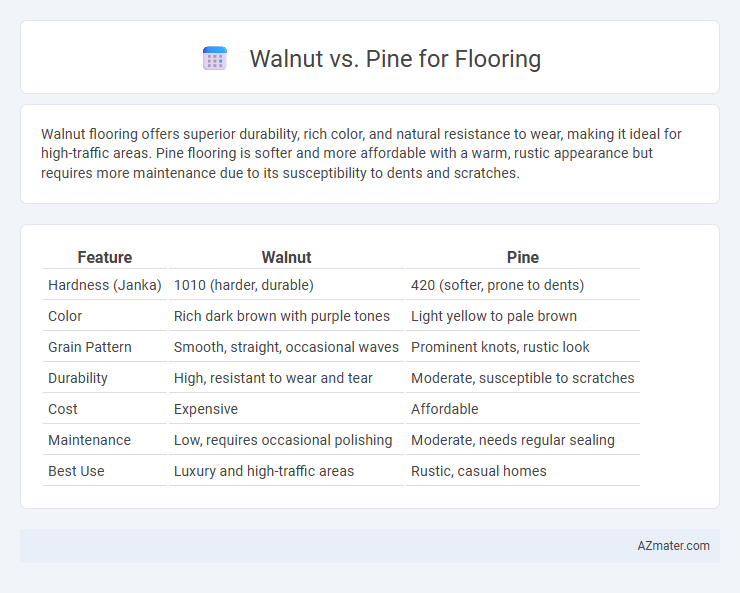Walnut flooring offers superior durability, rich color, and natural resistance to wear, making it ideal for high-traffic areas. Pine flooring is softer and more affordable with a warm, rustic appearance but requires more maintenance due to its susceptibility to dents and scratches.
Table of Comparison
| Feature | Walnut | Pine |
|---|---|---|
| Hardness (Janka) | 1010 (harder, durable) | 420 (softer, prone to dents) |
| Color | Rich dark brown with purple tones | Light yellow to pale brown |
| Grain Pattern | Smooth, straight, occasional waves | Prominent knots, rustic look |
| Durability | High, resistant to wear and tear | Moderate, susceptible to scratches |
| Cost | Expensive | Affordable |
| Maintenance | Low, requires occasional polishing | Moderate, needs regular sealing |
| Best Use | Luxury and high-traffic areas | Rustic, casual homes |
Overview of Walnut and Pine Flooring
Walnut flooring offers a rich, dark brown hue with intricate grain patterns, known for its durability and resistance to wear, making it ideal for high-traffic areas. Pine flooring, characterized by its lighter color and prominent knots, provides a softer, more rustic aesthetic but is less dense and more prone to dents and scratches. Both hardwood options vary significantly in hardness, maintenance needs, and visual impact, influencing their suitability for different interior styles and usage levels.
Appearance and Color Differences
Walnut flooring exhibits rich, deep brown hues with a smooth, fine grain pattern that adds warmth and elegance to interiors. Pine flooring features lighter, yellowish to pale brown tones with prominent knots and a more rustic, textured appearance, offering a casual or country-style look. The color stability of walnut tends to be superior, maintaining its dark richness over time, while pine may darken or develop a patina, enhancing its character.
Durability and Hardness Comparison
Walnut flooring offers a Janka hardness rating of approximately 1,010, providing moderate durability suitable for residential spaces with light to average foot traffic. Pine, with a lower Janka hardness rating around 380 to 870 depending on the species, is softer and more prone to dents and scratches compared to walnut. The higher density and hardness of walnut make it more resistant to wear, making it a superior choice for longevity and durability in flooring applications.
Cost and Affordability Factors
Walnut flooring typically costs between $8 to $15 per square foot, making it a premium option due to its rich color and durability. Pine flooring is more affordable, generally priced around $3 to $7 per square foot, appealing to budget-conscious homeowners. The lower cost of pine is offset by its softer nature, which may require more frequent maintenance compared to walnut's harder surface.
Installation Process and Challenges
Walnut flooring demands precise acclimation and careful handling due to its denser grain and higher hardness level compared to pine, which can complicate the installation process. Pine, being softer and more pliable, offers easier cutting and fastening but is prone to denting and may require more frequent maintenance post-installation. Both materials require moisture control, but pine's sensitivity to humidity changes necessitates stricter environmental monitoring during installation to prevent warping or cupping.
Maintenance and Care Requirements
Walnut flooring requires regular cleaning with a soft broom or vacuum to prevent scratches, along with occasional refinishing to maintain its rich color and smooth finish. Pine floors demand more frequent care due to their softer nature, including prompt spill cleanup to avoid staining and periodic resealing to protect against dents and moisture damage. Both hardwoods benefit from humidity control and the use of protective pads on furniture to extend their lifespan and preserve aesthetic appeal.
Environmental Impact and Sustainability
Walnut flooring, sourced from slower-growing hardwood trees, tends to have a higher environmental impact due to longer harvest cycles and greater resource use, whereas pine flooring comes from faster-growing softwood species, making it a more sustainable choice with quicker renewability. Pine's lower energy consumption during processing and its ability to be harvested more frequently contribute to reduced carbon footprint and better sustainability credentials. Choosing FSC-certified pine wood ensures responsible forestry practices, further enhancing its environmental benefits compared to walnut.
Suitability for Different Interior Styles
Walnut flooring exudes rich, dark tones and refined grain patterns, making it ideal for traditional, rustic, or modern luxury interiors that emphasize warmth and sophistication. Pine flooring offers a lighter, softer appearance with knots and imperfections that complement casual, cottage, farmhouse, and Scandinavian minimalist styles. Both woods vary in hardness and aging characteristics, influencing their appropriateness for high-traffic areas or vintage-inspired designs.
Pros and Cons of Walnut Flooring
Walnut flooring offers rich, dark tones and a luxurious appearance, providing a durable surface that resists wear, making it ideal for high-traffic areas. However, walnut is softer than many hardwoods, leading to susceptibility to dents and scratches, which may require more maintenance and care over time. Its higher price point compared to pine flooring reflects its premium aesthetic and durability, but may not fit all budget constraints.
Pros and Cons of Pine Flooring
Pine flooring offers affordability and a warm, rustic aesthetic with its softwood texture that easily absorbs stains and finishes, enhancing its natural grain patterns. Its softness makes it susceptible to dents and scratches, requiring regular maintenance to preserve its appearance in high-traffic areas. Pine's tendency to expand and contract with humidity necessitates proper acclimation and installation techniques to prevent warping or gaps over time.

Infographic: Walnut vs Pine for Flooring
 azmater.com
azmater.com